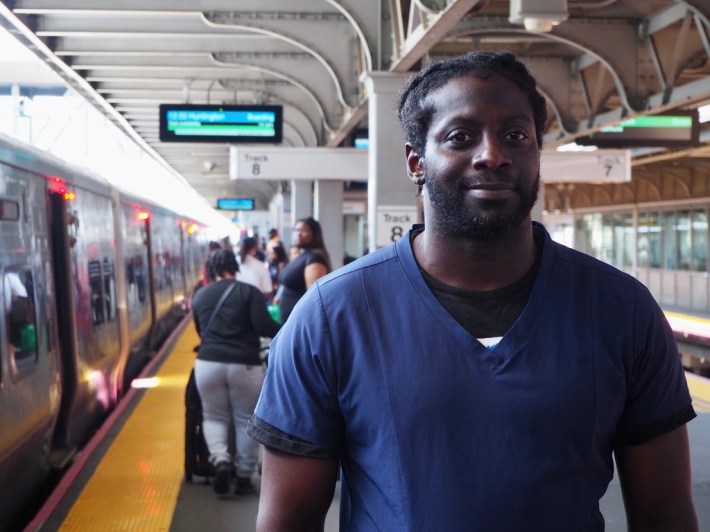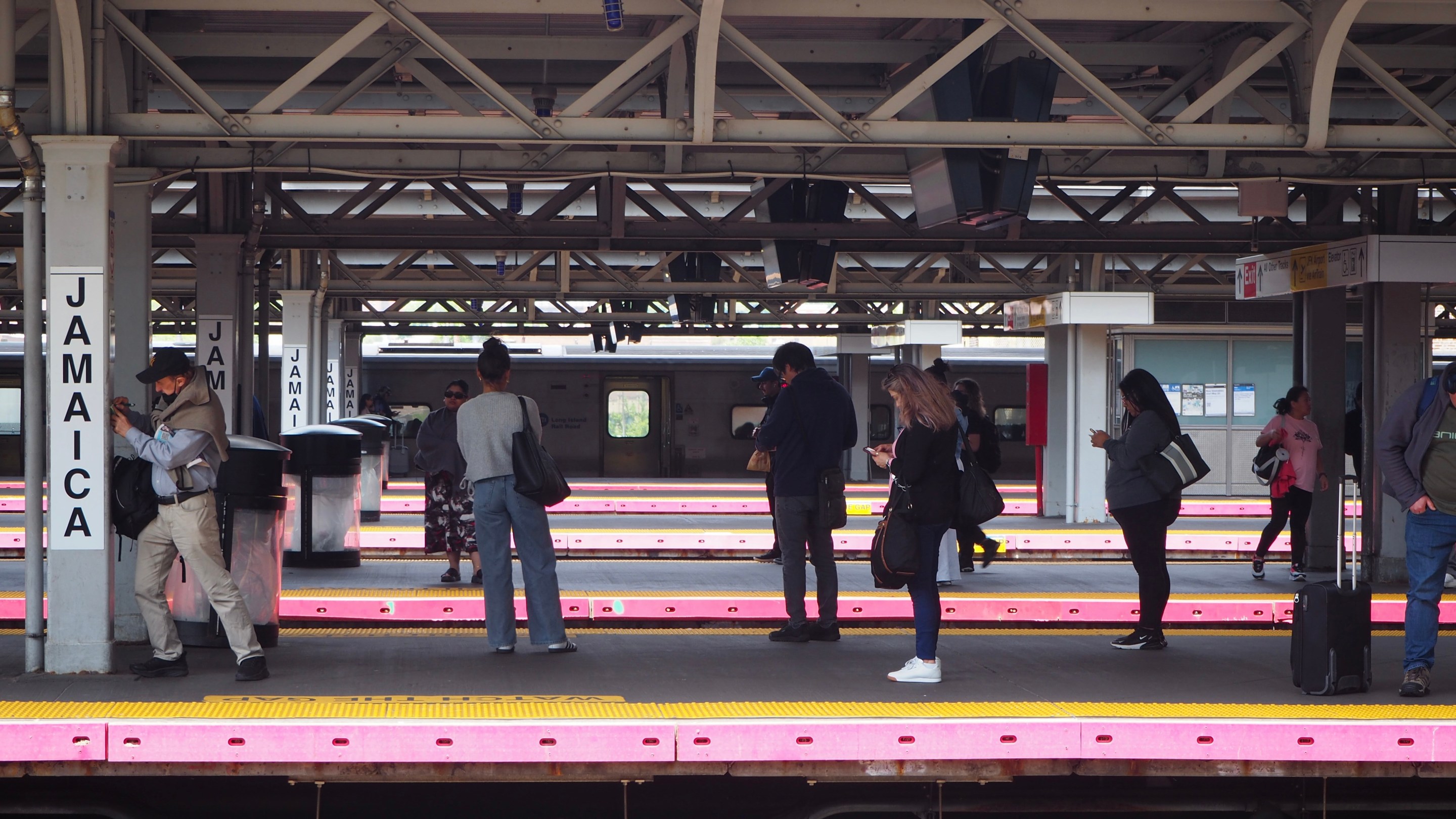Frustrated Long Island Rail Road commuters say it’s no way to run a railroad.
Ten thousand trains arrived at its Jamaica hub at least three minutes behind schedule — leaving riders with just seconds to make connections scheduled as tight as just 4 minutes apart following the railroad’s schedule overhaul last year with the opening of Grand Central Madison.
That’s 41 percent of the nearly 25,000 trains that passed through Jamaica over the seven weeks of data collected from the LIRR’s train-tracking systems and analyzed by Streetsblog.
The findings lay bare the operational difficulties that have contributed to LIRR’s paltry rider satisfaction ratings, which remain below levels posted before the opening of the $11.2 billion East Side terminal despite the commuter link’s official 96.8 percent on-time rate in April.
LIRR president Rob Free told Streetsblog in a statement that the railroad will begin formally tracking its performance through the Jamaica hub in response to the ongoing complaints.
“We have been proactive in improving service through Jamaica station, which is not an area the railroad has traditionally measured success,” he said. “The Chair [Janno Lieber] and I have pushed our analytics staff to develop refined metrics for Jamaica service so that we can develop schedule adjustments that help us achieve our goal more efficiently.”
An MTA official added that the LIRR schedules set to be issued this fall will attempt to better sync connections at Jamaica for the less frequent eastbound service back.
The launch of Grand Central Madison was accompanied by the biggest schedule shakeup at the LIRR in decades, including the railroad’s decision to end a longstanding practice of holding trains at Jamaica to allow passengers to easily make connections.
The agency’s verbiage changed too: What were once connections became “transfer opportunities,” which in turn, have been labeled “transfer requests” at least once by the LIRR on social media.
Apparently "transfer opportunities" have now become "transfer requests" 🫠 https://t.co/4IkQeyBdRz
— The LIRR Today (@TheLIRRToday) March 26, 2024
Schedules with so little flexibility mean a train running even a bit late can blow a connection and add a half-hour to a trip. The platform changes and random delays turn “change trains at Jamaica” into a track meet.
For aviation industry writer Jason Rabinowitz, of Brooklyn, the LIRR’s schedule rewrite added a half-hour to his trip to his trips back to see his parents who live off the Far Rockaway branch — and that’s only when everything goes according to plan.
Blown connections can add another hour on top of that thanks to infrequent weekend service.
“When I get to Jamaica, there’s still only one train an hour,” said Rabinowitz, who connects at Jamaica via the LIRR’s Brooklyn service out of Atlantic Terminal.
“If my shuttle coming in from Atlantic Terminal is three minutes late – now I only have a one minute to make the connection, or I miss it entirely and then you have to wait a whole hour for the next train,” Rabinowitz said.
The result: He visits his parents less, and when he does visit, he often uses a car.
Jermaine Hill, a home health aide, commutes from Brooklyn to Long Island and estimates that blown connections can add 30 to 45 minutes to his trip.
“They don’t wait, even if you’re [on a train] running late,” he said Monday as he waited for his connection at Jamaica on Monday.
Streetsblog’s data analysis — of 39,000 train trips over seven weeks across the LIRR’s network — reveals that the LIRR’s punctuality problems at Jamaica often begin downstream at its major western terminals, which are sending trains behind schedule 23 percent of the time.
Half of all trains departing from Atlantic over the examined time period, 1681 out of 3313, left at least two minutes behind their posted departure time.
Things were somewhat better at the brand spankin’ new $11.2 billion LIRR station beneath Grand Central. There, one-in-five trains, 1,101 of the 5,665, departed at least two minutes late.
But that’s worse than at heavily congested Penn Station where 13 percent of trains — 953 out of 7,573 — rolled two minutes or more after their departure time, despite promises from MTA and state officials Grand Central Madison would improve the LIRR’s reliability.
“It will be the LIRR's first entry point into Manhattan that isn't shared with other railroads, meaning greater reliability because of less exposure to service disruptions, and more flexibility for trains and riders to work around any that do occur,” the MTA said in a 2022 press release.
Despite all the delays at the three western terminals and blown connections at Jamaica, the LIRR is able to claim a 96 percent on-time rating by defining “on time” as within 6 minutes of schedule.
That means a train can be “on time” even if it departs late or arrives at Jamaica too late for passengers to change trains.
Metro-North tracks its on-time performance using the same standards, but its operation does not include a large transfer station susceptible to downstream delays like Jamaica.
Take the 6:03 p.m. train from Grand Central to Hempstead, Train #770:
It was at least two minutes late pulling out of the East Side terminal 29 out of the 32 weeknights that it ran during the period Streetsblog analyzed. It pulled into Jamaica at least three minutes late — and, at least once, as much as nine minutes late — 23 times out of 32 times, potentially turning connections into a foot-race at best or a ruined evening at worst.
However, the six-minute buffer at the end of the line meant that Train #770 was only officially late one out of those 32 times — on April 11, when it arrived at 7:06 p.m., which was 11 minutes behind schedule.
Ditto #1710, the 7:36 a.m. train from Atlantic to West Hempstead. It left Atlantic at least two minutes behind schedule 73 percent of the time, was between 3-6 minutes late traversing through Jamaica an astounding 97 percent of the time, but was only technically late reaching the end of the line in Nassau three out of 33 times under the 6-minute rule.

"It’s so tight in Jamaica that you can have two trains, one out of Penn, one out of Grand Central, and if one is running late, the connection could be gone,” said Gerry Bringmann, the representative for LIRR riders on the MTA’s board.
“Your train could be pulling in four minutes late, but your connection left a minute earlier,” he continued. “So, the customer experience doesn’t necessarily match up with the on-time performance.”
Bringmann added that number of complaints he has personally received have dropped off in recent weeks.
Long Island-to-Grand Central commuter Nico Mariano shared that assessment.
“There was a period of time when trains would run late, or [they’d] cancel trains and leave you stranded here at Jamaica,” he said while waiting for a train this week. “But it’s gotten better in the last year.”






